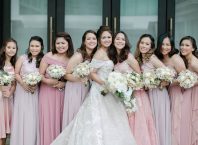By Karen Grace Pascual
The celebration of love and unity is performed in different cultures with different traditions and customs. The Chinese having a rich culture has an elaborate and festive way of tying the knot.
Here are some of the traditions that make up a Chinese wedding. See if you can fit some or all the traditions in the modern day setting. Customs may vary from different clans, regions and localities. Some of my sources did not include the exact region of these customs.
Bethrothal
The parents of the bride and the groom formally meet today. The female’s family picks an auspicious date from the suggested dates of the male’s family. Auspicious days a re subject to interpretation by fortunetellers that perform the analysis based on one’s birth date (day and hour) after consultation with the Chinese almanac. The 15 day period from the middle to the end of the seventh lunar month is considered inauspicious because that is time of the Hungry Ghost Festival when the gates of Hell are opened and the lost spirits are allowed to wonder the earth. Usually the whole seventh lunar month is considered inauspicious.
The 15 day period from the middle to the end of the seventh lunar month is considered inauspicious because that is time of the Hungry Ghost Festival when the gates of Hell are opened and the lost spirits are allowed to wonder the earth.
The male’s family will present the betrothal gifts which includes tea, dragon and phoenix bridal cakes, wine, pairs of male and female poultry, sweetmeats and sugar. In extremely rich families, they even send out jewelry. Tea is a primary part of these gifts
Pre-Wedding
Giving out invitations is a must for every wedding. But the Chinese really does it with style. They send out Double Happiness cakes to the close friends and relatives to announce their wedding. Along with these cakes comes an invitation printed on red paper. Those who received it must give them a congratulatory gift on the wedding day.
Another pre-wedding ritual is installing the bridal bed probably for the couples first tonight together. A respected relative considered a good luck man or good luck woman, one man or women with many children and living mates will install the bed. Installing the bed means moving the bed slightly or putting the bed cover and the pillows. Once the bed is installed, children (as many as you want) are asked to play on the bed. Later on they will scatter red dates, pomegranates and other fruits.
The female has to bathe in water infused with pomelo skin or peelings or leaves, to clense her of the bad things.
Wedding Day
Wedding day for a Chinese custom, is equally tiring as of a western culture. The female has to bath in water infused with pomelo skin or peelings or leaves, to cleanse her of the bad things. Then a good luck woman will come to help dressing up the bride’s hair. The woman should also speak auspicious words while tying up her hair in a bun, a style of married woman.
The female’s face will be covered with either a red silk veil or a ‘curtain’ of tassels or beads that hung from the bridal Phoenix crown. For the males, a capping ritual is done. The male will kneel at the family altar while his father placed a cap decorated with cypress leaves on his head. They will set up the bridal sedan chair to pick up the bride along with the relatives and friends.
In some cases, the groom would take dinner with the bride’s family, and receive a pair of chopsticks and two wine goblets wrapped in red paper, symbolic of his receiving the joy of the family in the person of their daughter. In some regions, he would be offered sweet longan tea, two hard-boiled eggs in syrup and transparent noodles. Another variation was the groom’s partaking of soup with a soft-boiled egg, the yolk of which he was expected to break, arguably symbolic of breaking the bride’s ties with her family.
Another variation was the groom’s partaking of soup with a soft-boiled egg, the yolk of which he was expected to break, arguably symbolic of breaking the bride’s ties with her family.
The festive procession of picking up the bride includes firecrackers and loud gongs. The groom led the procession accompanied by a child as an omen of his future sons, and attendants with lanterns and banners, musicians, and a ‘dancing’ lion or unicorn followed the bridal sedan chair.
The ‘good luck woman’ carried the bride on her back to the sedan chair. Another attendant might shield the bride with a parasol while a third tossed rice at the sedan chair. Shocking as it may sound, it is written that the bride cannot touch the bare earth. Great care was taken to ensure that no inauspicious influence would affect the marriage.
The female attendants were chosen with particular care that the horoscope animals of their birth years were compatible with that of the bridegroom. The sedan chair was heavily curtained so that the bride may avoid seeing unlucky things.
The wedding ceremony only takes about a few minutes with the bride and the groom going to the family altar. They pay homage to the Heaven and Earth, the family ancestors and then to their parents. The groom’s parents are offered with tea with two lotus seeds or dates in the cup. After they bowed, the ceremony is over. In some other rituals, where both also drank wine from the same goblet, ate sugar molded in the form of a rooster, and partook of the wedding dinner together.
Wedding Banquet
Of course, food is one thing present in all occasions. The Chinese wedding banquet usually consists of fish, roast suckling pig, pigeon, chicken cooked in red oil, lobster and desert bun with lotus seeds stuffed inside. Each dish represents a significant wish for the young couple. The fish sounds like ‘yu’ which means abundance. The roast suckling pig symbolizes bride’s purity. Pigeon implies peaceful future while the chicken which also means ‘phoenix’ cooked in red oil symbolizes a wish for a good life. The lobster is literally called ‘dragon shrimp ‘ in Chinese. The lobster and chicken is a yin yang and represents a balance that must be met like the marriage of man and woman.
Getting married was never easy in every culture. All preparations and cooperation from both sides are needed. There is chaos, miscommunication, panic, almost everything can happen between the preparations and the wedding day itself. But amidst of this all, a wedding, whether Chinese or Filipino, American or African, is a symbol of unity and harmony that man and a woman is bound to. It is, as cliché as it may sound, a celebration of love that will last forever.
. . . . . . . . . . . . . . . . . . . . . . . . . . . . . . . . . . . . . . . . . . . . . . . . . . . . . . . . . . . . . . . . . . . . . . .
References:
http://www.chcp.org
http://www.chinabridal.com
About Tsinoy.com
Tsinoy.com is an online community for the Filipino-Chinese around the world. Tsinoy.com advocates the incomparable significance of the Chinese and Filipino culture in our modern-day society. It features articles, forums and a matchmaking section that both Tsinoys and Pinoys can relate to.




